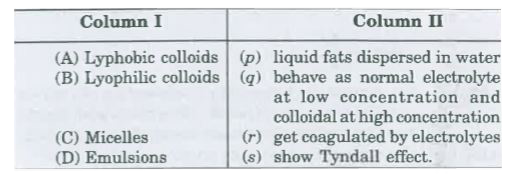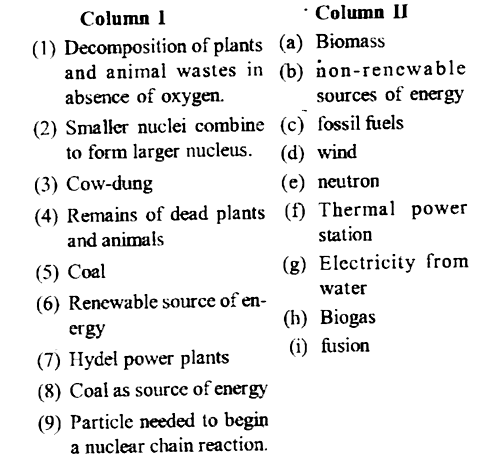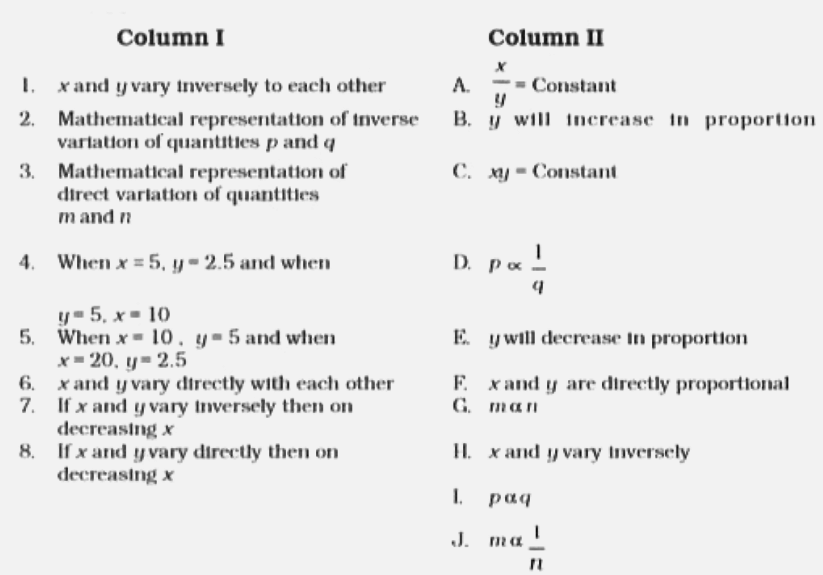Match the entries of column I with appropriate entries of column II and choose the correct option out of the four options (a) , (b) , ( c) ,(d ) given at the end of each questions.
Column I Column II(A)F(p)Maximum ionization enthalpy (B)C1(q) Maximum atomic radius (C)He(r)Maximum electronegativity (D)Cs(s) Maximum negative electron gain enthalpy
A−q,B−s,C−r,D−p
A−r,B−s,C−p,D−q
A−r,B−p,C−q,D−s
A−q,B−p,C−s,D−r
The correct Answer is:B
To solve the matching question between Column I and Column II, we need to analyze each entry in both columns and determine the correct pairings based on the properties of the elements.
1. Identify the Elements in Column I:
- (A) F (Fluorine)
- (B) Cl (Chlorine)
- (C) He (Helium)
- (D) Cs (Cesium)
2. Identify the Properties in Column II:
- (p) Maximum ionization enthalpy
- (q) Maximum atomic radius
- (r) Maximum electronegativity
- (s) Maximum negative electron gain enthalpy
3. Match Each Element with Its Property:
- (A) F (Fluorine): Fluorine is known for having the highest electronegativity among all elements. Therefore, it matches with (r) "Maximum electronegativity".
- (B) Cl (Chlorine): Chlorine is a halogen and has a high tendency to gain electrons, thus it has a high negative electron gain enthalpy. It matches with (s) "Maximum negative electron gain enthalpy".
- (C) He (Helium): Helium is a noble gas and has a very high ionization enthalpy because it does not want to lose its electrons. It matches with (p) "Maximum ionization enthalpy".
- (D) Cs (Cesium): Cesium is known for having the largest atomic radius among the alkali metals. It matches with (q) "Maximum atomic radius".
4. Final Matching:
- (A) F → (r) Maximum electronegativity
- (B) Cl → (s) Maximum negative electron gain enthalpy
- (C) He → (p) Maximum ionization enthalpy
- (D) Cs → (q) Maximum atomic radius
Conclusion:
The correct matches are:
- A → r
- B → s
- C → p
- D → q
- (A) F (Fluorine)
- (B) Cl (Chlorine)
- (C) He (Helium)
- (D) Cs (Cesium)
- (p) Maximum ionization enthalpy
- (q) Maximum atomic radius
- (r) Maximum electronegativity
- (s) Maximum negative electron gain enthalpy
- (A) F (Fluorine): Fluorine is known for having the highest electronegativity among all elements. Therefore, it matches with (r) "Maximum electronegativity".
- (B) Cl (Chlorine): Chlorine is a halogen and has a high tendency to gain electrons, thus it has a high negative electron gain enthalpy. It matches with (s) "Maximum negative electron gain enthalpy".
- (C) He (Helium): Helium is a noble gas and has a very high ionization enthalpy because it does not want to lose its electrons. It matches with (p) "Maximum ionization enthalpy".
- (D) Cs (Cesium): Cesium is known for having the largest atomic radius among the alkali metals. It matches with (q) "Maximum atomic radius".
- (A) F → (r) Maximum electronegativity
- (B) Cl → (s) Maximum negative electron gain enthalpy
- (C) He → (p) Maximum ionization enthalpy
- (D) Cs → (q) Maximum atomic radius
The correct matches are:
- A → r
- B → s
- C → p
- D → q
Topper's Solved these Questions
- BOOK - PRADEEPCHAPTER - CLASSIFICATION OF ELEMENTS AND PERIODICITY IN PROPERTIES EXERCISE - Competition Focus (Jee Main and Advanced / Medical Entrance ) ( Matrix - Match Type question V )2videos
CLASSIFICATION OF ELEMENTS AND PERIODICITY IN PROPERTIES
- BOOK - PRADEEPCHAPTER - CLASSIFICATION OF ELEMENTS AND PERIODICITY IN PROPERTIES EXERCISE - Competition Focus (Jee Main and Advanced / Medical Entrance ) ( Integer Type Question VI)6videos
CLASSIFICATION OF ELEMENTS AND PERIODICITY IN PROPERTIES
- BOOK - PRADEEPCHAPTER - CLASSIFICATION OF ELEMENTS AND PERIODICITY IN PROPERTIES EXERCISE - Competition Focus (Jee Main and Advanced / Medical Entrance ) ( Multiple Choice Question III ) (Based on the given passage / Comprehension ) (Comprehension 1 )5videos
CLASSIFICATION OF ELEMENTS AND PERIODICITY IN PROPERTIES
- BOOK - PRADEEPCHAPTER - CHEMICAL BONDING AND MOLECULAR STRUCTUREEXERCISE - Curiosity Questions2videos
CHEMICAL BONDING AND MOLECULAR STRUCTURE
- BOOK - PRADEEPCHAPTER - ENVIRONMENTAL CHEMISTRYEXERCISE - COMPETITION FOCUS (JEE(Main and Advanced)/Medical Entrance (VI.ASSERTION-REASON) Type II6videos
ENVIRONMENTAL CHEMISTRY
Similar Questions
Knowledge Check
- Question 1 - Select One
Match the entries of Column I with appropriate entries of Column II and select the correct option.
 AP-1, Q-2, R-3, S-4BP-2, Q-3, R-4, S-1CP-2, Q-1, R-4, S-3DP-3, Q-2, R-1, S-4
AP-1, Q-2, R-3, S-4BP-2, Q-3, R-4, S-1CP-2, Q-1, R-4, S-3DP-3, Q-2, R-1, S-4 - Question 2 - Select One
Match the entries of column I with appropriate entries of column II and choose the correct option but of the four options (a), (b), (c ), (d) given at the end of each question.
Column IColumn II(A)Siderite(p)Zinc(B)Chalcocite(q)Aluminium(C)Calamine(r)Copper(D)Bauxine(s)IronAA-s, B- r, C-p, D-qBA-p, B-s, C-r, D-qCA-q, B-r, C-s, D-pDA-r, B-q, C-p,D-s - Question 3 - Select One
Match the entries of column I with appropriate entries of column II and choose the correct option out of the four option (a), (b), (c), (d) given at the end of each question.
Column IColumn II(A) femto(p) 109(B) yotta(q) 10−15(C) giga(r) 10−18(D) atto(s) 1024AA-q, B-p, C-r, D-sBA-s, B-q, C-p, D-rCA-q, B-s, C-p, D-rDA-r, B-s, C-p, D-q
Match the entries of Column I with appropriate entries of Column II and select the correct option
 View Solution
View SolutionMatch the entries of Column I with appropriate entries in Column II.
 View Solution
View SolutionMatch the entries given in Column I with appropriate ones in Column II
 View Solution
View SolutionMatch each of the entries in Column I with the appropriate entry in Column II
 View Solution
View SolutionMatch each of the equation in Column I with the appropriate entries in Column II.
 View Solution
View Solution



